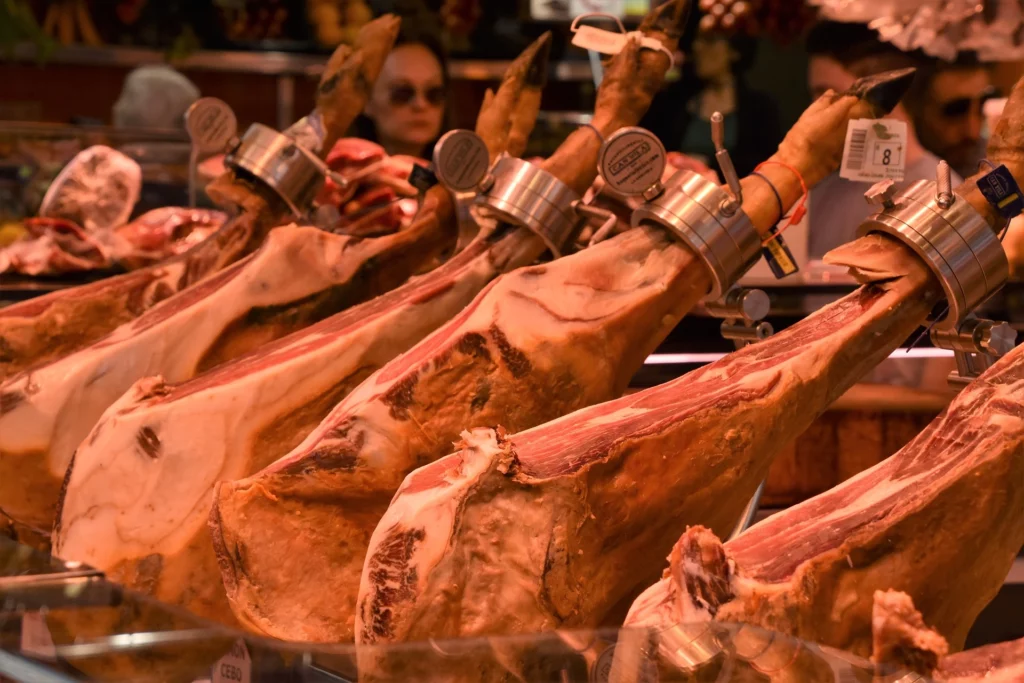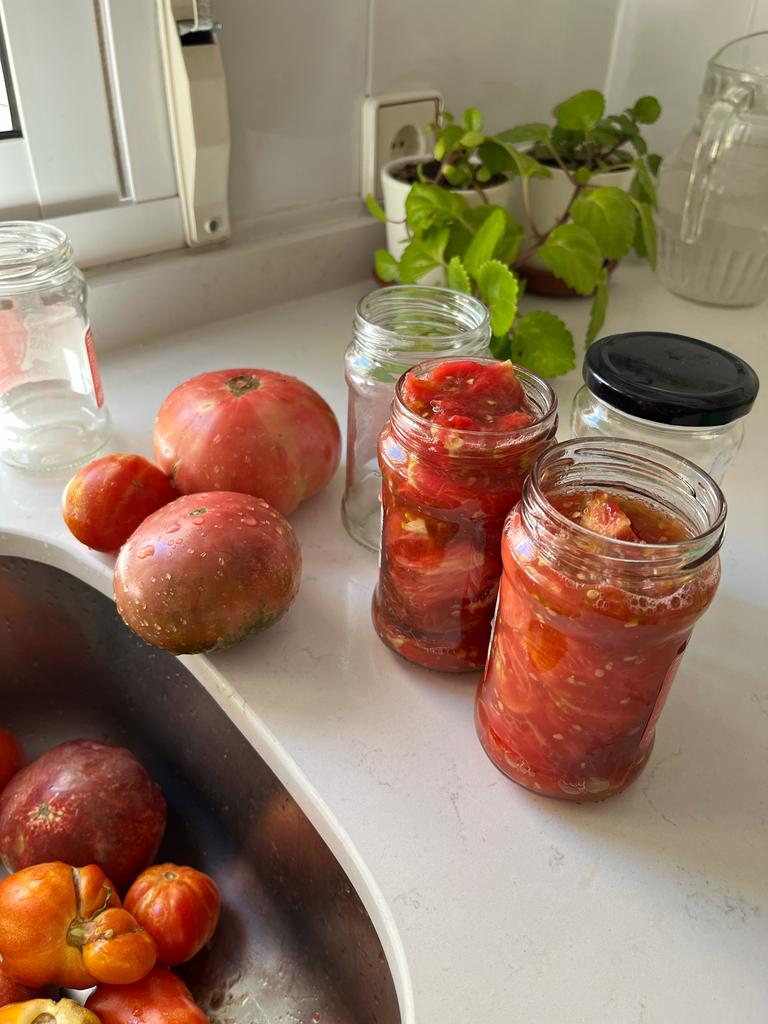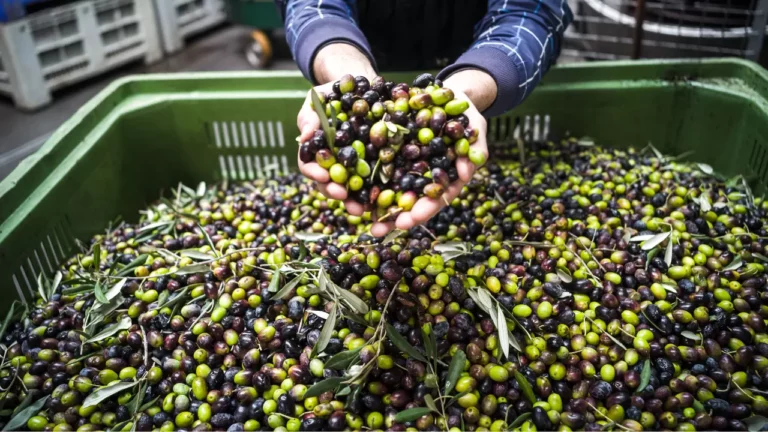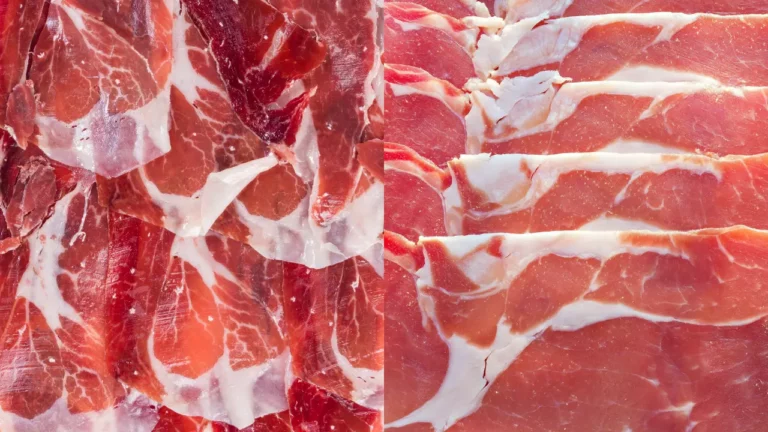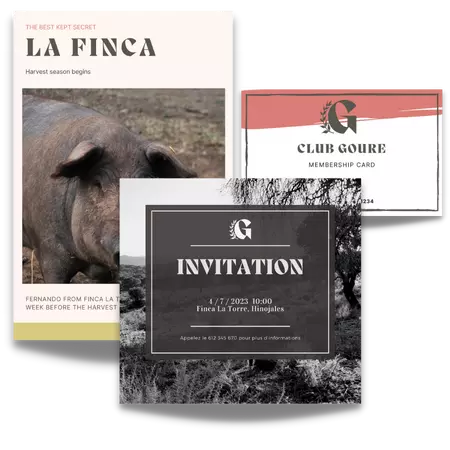Jamon Iberico is a true delicacy – the very best of the best in cured ham. But while its delicious flavor and juicy texture make it a coveted treat, choosing the right Jamon Iberico can be daunting. Luckily, this article provides an ultimate guide to selecting the perfect Jamon Iberico for any occasion. Read on to learn about the differences between Jamon Iberico de Bellota, Jamon Iberico de Recebo, and Jamon Iberico de Cebo, which factors to consider when making a selection, and tips for preparing and serving the perfect Jamon Iberico dish.
Table of Contents
Introduction to Jamon Iberico
Jamon Iberico is a type of cured ham that is made from the Iberian breed of pigs. This highly sought-after ham has a unique flavor and texture, as well as a high fat content. This flavor and texture, in combination with the extended curing process, results in an intense yet sweet taste.
Jamon Iberico has been a culinary staple in Spanish cuisine for centuries, and its popularity is continuing to grow in the United States and other parts of the world. It is distinguished from jamon Serrano (another type of cured ham) primarily in its curing process. Jamon Serrano must be cured for at least ten months, whereas jamon Iberico can be left to cure up to three years. This extended curing time contributes to higher fat content and develops the more intense flavor profile that jamon Iberico is known for.
Furthermore, jamon Serrano is typically made from Cerdo Ibérico Puro (Iberian pure pig) or Cerdo Ibérico Rubia Gallega (Galician Blonde Iberian pig). On the other hand, jamon Iberico is produced by crossbreeding these two breeds together with Duroc pig, creating a richer flavor profile even further.
In conclusion, jamon Iberico stands out amongst traditional cured hams due to the long curing process which results in an unbeatable flavor profile. It’s no surprise why this type of ham has become so beloved in Spain and beyond. When selecting the best jamon Iberico, there are several factors to consider such as curing time, aroma, texture and fat content which we will discuss in greater detail later on in this article.
Types of Jamon Iberico
Jamon Iberico is a type of cured ham that is produced exclusively in Spain. It is made from black Iberian pigs native to the country and has become an iconic culinary delicacy in Spanish cuisine. While there are many different varieties of Jamon Iberico available, they can be divided into three main categories – Jamon Iberico de Bellota, Jamon Iberico de Recebo, and Jamon Iberico de Cebo. In this section, we will provide an overview of each type and discuss their key differences.
First, let’s look at Jamon Iberico de Bellota. This is the highest quality type of Jamon Iberico available. To qualify as Jamon Iberico de Bellota, the pigs must be free-range, fed only natural foods such as acorns and wild herbs for at least four months prior to slaughter, and raised humanely in controlled conditions. As a result of this process, the resulting product has an intense flavor and aroma due to the long curing time (up to 48 months) and high fat content (up to 7%). Due to its rich flavor, Jamon Iberico de Bellota is often served thinly sliced on its own or as part of a variety of tapas dishes.
Next, let’s take a look at Jamon Iberico de Recebo. This type of Jamon Iberico is slightly lower quality than Bellota but still very popular in Spain. To qualify as Jamon Iberico de Recebo, the pigs must be raised mostly free-range but fed a combination of natural foods such as acorns and cereals for at least two months prior to slaughter. As a result of this process, the resulting product has a milder flavor than Bellota due to the shorter curing time (6-32 months) and lower fat content (4-6%). It is usually served sliced thickly on its own or as part of various dishes such as sandwiches and salads.
Finally, let’s discuss Jamon Iberico de Cebo. This type of Jamon Iberico is generally considered to be the lowest quality of all three types. To qualify as Jamon Iberico de Cebo, the pigs must be raised primarily in barns on cereals and grains with no access to pasture or feed from natural sources. As a result, the resulting product has
Jamon Iberico de Bellota
Jamon Iberico de Bellota is the highest grade of Jamon Iberico available today and is generally considered to be of the finest quality compared to other types of Jamon Iberico such as Jamon Serrano, Jamon Iberico de Recebo, and Jamon Iberico de Cebo. This type of Jamon is made from black-footed pigs that have been fed only acorns and grass for at least the last four months of their lives. As such, it has a higher fat content than other types of Jamon Iberico which gives it a richer flavor and texture when served.
The curing process of Jamon Iberico de Bellota takes place over a minimum of 36 months, allowing it to develop an intense aroma and savory flavor that can’t be found in other types of cured meats. The curing process also results in the fat being evenly distributed throughout the meat which makes it more tender and juicy when cooked or eaten raw. In addition, the characteristic marbling of fat gives it a unique flavor profile as well as adds to its overall visual appeal.
Jamon Iberico de Bellota has a distinctive aroma and buttery flavor that sets it apart from other cured meats; its richness and intensity come from the nutty notes imparted by the acorns consumed by the pigs during their lifetime. Its unique taste pairs perfectly with cheese, olives, crusty bread, and wine; making it an ideal accompaniment for any meal or gathering.
The fat content in Jamon Iberico de Bellota is higher than other types of Jamon Iberico which helps to add to its unique flavor profile as well as making it an excellent source of healthy fats when eaten in moderation. Its high fat content also means that it should be cooked or served using low-heat methods such as roasting or baking in order to ensure that all its flavors are fully developed without burning or over-cooking the meat. It is also important to remember that this type of Jamon should be served at room temperature for maximum enjoyment.
Overall, Jamon Iberico de Bellota stands apart from other types of cured meats due to its superior quality, intense aroma and deep flavor; these qualities make it the perfect choice for any special occasion or gathering. With proper care and attention during preparation, this type of Jamon can truly elevate any dish with its distinct taste and texture.
Jamon Iberico de Recebo
Jamon Iberico de Recebo is a type of Spanish cured ham derived from a cross between Jamon Iberico de Bellota and Jamon Serrano. It contains characteristics of both types of jamón, yet it is generally less expensive than either. The curing process used for jamón iberico de recebo is shorter than that of iberico de bellota or serrano, lasting anywhere from six months to two years. This shorter curing period gives the meat an intense flavor, distinguishing it from other types of Spanish cured hams.
The fat content in jamón iberico de recebo also tends to be lower than either of its parent varieties. This makes it more suitable for those who may be looking for a lighter option when selecting a cured ham. Despite this, the flavor remains bold and distinctive, with just enough fat to add complexity to the dish without overwhelming it.
When selecting jamón iberico de recebo, one should consider the curing time, aroma, texture, and fat content in order to find the best quality product for their needs. The aroma should smell salty and slightly smoky, while the texture should remain moist with a slight chewiness. Additionally, since the fat content is usually lower than that of other types of cured hams, one should ensure that they select the best quality product with sufficient fat content for their desired taste and texture.
Once you have discovered the best product for your needs, you can proceed with preparing and serving your jamón iberico de recebo according to your desired tastes and preferences. To ensure that your jamón is properly cooked and served at its best flavor, follow these steps: firstly, pre-heat your oven to 350°F; secondly, remove the skin and excess fat from the meat; thirdly, cut thin slices across the grain; fourthly, place slices onto an ovenproof baking tray; fifthly, bake in the preheated oven until golden brown; lastly, allow your jamón iberico de recebo to rest before serving.
In conclusion, Jamon Iberico de Recebo is an excellent choice for those seeking out a Spanish cured ham with characteristic flavor yet relatively lower cost than Jamon Iberico de Bellota or Serrano. By carefully considering factors such as curing time, aroma, texture, and fat content when selecting your product and following these simple steps when preparing and serving it you
Jamon Iberico de Cebo
Jamon Iberico de Cebo is the third type of Jamon Iberico, made from acorn-fed pork and typically cured for 12 to 18 months. Although this type of Jamon Iberico tends to be less expensive than its counterparts, it still offers a high-quality experience. In terms of taste, Jamon Iberico de Cebo has a light aroma and a somewhat firm texture. Additionally, it contains higher levels of fat content than other types of Jamon Iberico, making it a great choice for those who are looking for something with a higher fat content but don’t want to sacrifice flavor or quality.
When selecting Jamon Iberico de Cebo, it’s important to look at several factors. First, make sure that the product has been aged properly; the longer the curing time, the better the end result will be. Second, pay attention to the product’s aroma and texture; not only should it smell pleasant, but it should also feel slightly firm when cut open. Finally, consider the fat content; if you’re looking for something that is juicy and fatty, then Jamon Iberico de Cebo is likely to be your best bet.
Once you have selected your desired product, there are several tips you can follow to ensure you get the most out of your Jamon Iberico de Cebo. First and foremost, make sure you store it correctly; place it in a cool and dry environment away from direct sunlight and keep it wrapped in special paper in order to protect it from bacteria and other external elements. Additionally, when serving Jamon Iberico de Cebo, make sure you slice it very thin in order to maximize its flavor and texture. Finally, serve it with accompaniments such as manchego cheese or olives for an even more delicious experience.
In conclusion, choosing the best Jamon Iberico de Cebo is not just about price – it’s also about looking for signs of quality such as proper curing time, tantalizing aromas and textures, and high fat content. By paying attention to these factors and following these tips on preparing and serving the product, you can rest assured that you will enjoy an excellent dining experience every time.
Factors to Consider When Selecting the Best Jamon Iberico
When it comes to selecting the best Jamon Iberico, there are several factors to consider. These include curing time, aroma, texture, fat content, and origin of production. Understanding these factors and their impact on the taste and texture of Jamon Iberico will help ensure that you select the perfect ham for your needs.
Curing time is an important factor to consider when selecting the best Jamon Iberico. This determines the amount of time that the ham has been hung and allowed to dry in a controlled environment, which helps to bring out its unique flavour and aroma. Generally, longer curing times result in more intense flavours and aromas, while shorter curing times produce milder hams with more subtle flavours and aromas. On average, Spanish hams are cured for at least 12 months, while Italian hams may be cured for as little as 6 months.
In addition to curing time, the aroma of Jamon Iberico can vary depending on its origin and curing process. Spanish hams typically have a characteristic nutty scent with hints of sweet spices like cinnamon and nutmeg, while Italian hams tend to have more intense smoky aromas with notes of herbs like rosemary and thyme. When selecting a ham, it is important to take into account your own personal preferences so that you can choose the best Jamon Iberico for your taste.
The texture of Jamon Iberico can range from firm and dense to soft and tender. This depends on the cut used for producing the ham as well as its cure time. Thicker slices tend to have a firmer texture due to their increased water retention during slicing, while thinner slices tend to be softer due to their reduced water retention during slicing. For those looking for juicier hams with a softer texture, thicker slices are recommended; however, if you prefer a firmer texture with more intense flavour then thinner slices are suggested.
Fat content is another important factor to consider when choosing Jamon Iberico as it affects the flavour and texture of the ham. A higher fat content produces a softer texture with more intense flavour, while a lower fat content produces a firmer texture with milder flavours. Additionally, Spanish hams tend to have higher fat contents than Italian hams due to their longer curing times, resulting in richer and more intense flavours.
Finally, the region where the pork was raised also affects the flavour of
Curing Time
Jamon Iberico is a type of cured ham made from the acorn-fed Iberian pig that comes in three different types, each of which requires different curing times. The curing time of Jamon Iberico is one of the most important factors to consider when selecting the best one. Properly cured Jamon Iberico should have a unique aroma and rich texture that are only acquired with the ultimate patience and attention to detail.
Jamon Iberico de Bellota has the longest curing time of up to 16 months, with a minimum of 14 months in some cases. It is the most expensive type of Jamon Iberico and it’s made exclusively from free-range, acorn-fed Iberian pigs. The marbling in these hams comes from its diet of acorns, giving it an unparalleled sweetness and complexity.
Jamon Iberico de Cebo takes about 12 months to cure and it’s made from semi-free range pigs. It’s fed on a mixture of natural grains such as corn and barley alongside some commercial feed. While still very high quality, this type of ham tends to be slightly less flavorful than the Bellota, but it’s still highly appreciated by many gourmets.
Finally, Jamon Iberico de Recebo takes around 8-12 months to cure, depending on size and shape. It’s made from pigs that are raised on farms and are fed on commercial feed. Typically this type of Jamon Iberico will be slightly less expensive than the other two styles but still provides amazing flavor profiles for those who appreciate cured ham.
In conclusion, the curing time for each type of Jamon Iberico plays an important role in selecting the best option for your needs. Whether you opt for Jamon Iberico de Bellota, Jamon Iberico de Cebo, or Jamon Iberico de Recebo, make sure you keep in mind all the factors mentioned above regarding curing time in order to choose the perfect one for your table!
Aroma
Aroma is an important factor to consider when selecting the best type of Jamon Iberico for your needs. Jamon Iberico de Bellota has a unique and intense aroma that comes from being fed a diet of acorns and grasses while living in the oak forests of Spain. This variety is renowned for its distinctive nutty scent, which lends itself well to certain dishes. Furthermore, the leaner texture of Jamon Iberico de Bellota allows its aroma to fully develop while curing, making it an excellent choice for those looking for a strong flavor profile.
In comparison, the aroma of Jamon Iberico de Recebo is more subtle and delicate than that of Jamon Iberico de Bellota. This variety exhibits a balance between fat and lean, providing a richer flavor without overpowering the senses. As such, it is ideal for those who prefer a milder flavor profile. Finally, Jamon Iberico de Cebo has a milder, less distinctive aroma compared to other varieties of Jamon Iberico. This variety is fattier than the other two and thus has a sweeter aroma.
However, the aroma of any variety of Jamon Iberico can vary depending on its curing time, fat content, and texture. For instance, if the jamón ibérico has been cured for longer periods, it will develop a stronger smell. Similarly, if the fat content is higher, it may give off an oily scent rather than one that is nutty or sweet. Therefore, it is important to consider all these factors before purchasing any type of jamón ibérico.
Texture
The texture of Jamon Iberico is one of the most important factors to consider when selecting the best option. The texture of a Jamon Iberico largely depends on how long it has been cured and aged. Jamon Iberico de Bellota, which is made with 100% pure-bred acorn-fed Iberian pigs, is typically cured for at least 36 months, while Jamon Iberico de Recebo and de Cebo are usually cured for much shorter periods of time. As a result, Jamon Iberico de Bellota has a softer texture than Jamon Iberico de Recebo or de Cebo.
The ideal texture of a Jamon Iberico should be firm but not tough, and creamy and melt-in-the-mouth. It should also dissolve easily in the mouth without leaving any residue behind. The surface of the jamon should be fine grainy, with streaks of fat running across it, and it should have a pleasant aroma that is not overly strong or pungent. Additionally, it should have just the right amount of fat for an optimal flavor and tenderness.
When choosing your ideal Jamon Iberico, you should take into account the curing time and texture to ensure that you select a product that best meets your needs and expectations.
Fat Content
Fat content is an important factor to consider when selecting the best Jamon Iberico for your needs. The fat content of each type of Jamon Iberico varies, with the highest quality types having a higher fat content than the lower quality types. This is because the fat content of the jamón reflects the diet and lifestyle of the pig it came from – the acorn-rich diet of Jamón Ibérico de Bellota gives it significantly more marbling than other types of Jamón Ibérico, making it superior in quality and flavour.
It is important to note that too much fat can actually detract from the flavour of Jamon Iberico and make it less enjoyable to eat. The higher percentage of intramuscular fat in an Ibérico ham enhances its flavour and makes it more succulent due to increased moisture retention during cooking. On the other hand, too much fat can make the ham overly greasy, which makes it difficult to appreciate its flavour and texture. For this reason, it is important to find a balance between finding a Jamon Iberico with a high fat content but not too high so that you get the best flavor experience possible.
When looking at labels or selecting a piece in person, it is useful to look for hams that have a good amount of marbling. The marbling should be evenly distributed and look like thin veins throughout the meat rather than being concentrated in one area. Additionally, when cutting through the meat, there should be enough fat to give it an even appearance throughout – if you see large chunks of fat, this may be a sign that there is too much fat in that particular piece.
In conclusion, while fat content plays an important role in determining the overall quality and flavour of Jamon Iberico, it is important to find a balance between selecting a ham with high fat content but not too high so that you can enjoy the best flavor experience possible.
Tips for Serving Jamon Iberico
When preparing and serving Jamon Iberico, it is important to keep a few key points in mind. Firstly, Jamon Iberico should always be served at room temperature for the best taste and texture – to achieve this, the Jamon Iberico should be taken out of the refrigerator approximately 30 minutes before serving. Additionally, a good quality Jamon Iberico knife should be used when slicing the meat in order to ensure thin slices that allow for more even cooking and more flavor. Moreover, it is not recommended to chop up the Jamon Iberico due to its delicate texture which can become dry and tough if chopped too much.
The fat content of the Jamon Iberico should also be taken into consideration when preparing it. The fat helps preserve the moisture and tenderness of the meat while also adding extra flavor. For a leaner option, look for low-fat varieties such as Jamon Iberico de Recebo or Jamon Iberico de Cebo. For a richer option with higher fat content, look for Jamon Iberico de Bellota, which is cured for much longer than other types of Jamon Iberico and has a higher fat content as a result.
Finally, there are many accompaniments that go well with Jamon Ibérico such as olives, cheese, nuts, and grapes depending on your preference and desired flavors. Experimenting with different combinations will help you find the perfect pairing for your meal! To facilitate this process, consider seeking advice from a knowledgeable retailer who can make suggestions tailored to your taste.
In conclusion, when preparing and serving Jamon Iberico there are several key points to keep in mind. Firstly, Jamon Iberico should always be served at room temperature – to do this, take it out of the refrigerator 30 minutes before serving. Secondly, use a good quality knife when slicing up your Jamon Iberico in order to get thin slices that allow for even cooking and more flavor. Thirdly, pay attention to the fat content of your chosen Jamon Iberico – select low-fat varieties such as Jamon Iberico de Recebo or Jamon Iberico de Cebo if you prefer something leaner; alternatively select Jamon Iberico de Bellota which has been cured for much longer and is higher in fat content. Finally, consider pairing your Jamon Iberico with accompaniments such
Checklist for Choosing the Best Jamon Iberico
When it comes to choosing the best Jamon Iberico for your needs, it is important to evaluate the type of Jamon Iberico that best suits your needs. Jamon Iberico is a high-quality cured ham from Spain which can be divided into three varieties – Jamon Iberico de Bellota, Jamon Iberico de Recebo, and Jamon Iberico de Cebo. Each variety has its own unique characteristics such as curing time, aroma, texture and fat content. To ensure you choose the right Jamon Iberico for your needs, it is important to consider these factors before making your purchase.
When selecting Jamon Iberico, there are several factors to consider in order to make sure you purchase the best product available:
- Curing Time: The curing time of each of the three types of Jamon Iberico varies based on their quality and region of origin. For example, Jamon Iberico de Bellota must be cured for a minimum of 36 months; this adds complexity and depth of flavor to the product.
- Aroma: The aroma of a cured ham indicates how mature it is and how long it has been cured for. It should have a pleasant smell and not be too pungent.
- Texture: The texture of a cured ham should be firm yet moist. It should feel creamy and velvety in the mouth with a slight crunch when bitten into.
- Fat Content: The fat content of a cured ham will also vary according to its quality and region of origin. Generally speaking, the higher quality hams have a higher fat content which helps to add flavor and tenderness to the meat.
To make sure you select the best possible Jamon Iberico for your needs, here is a helpful checklist you can use when making your selection:
- Check the label to ensure you are buying authentic Spanish Jamon Iberico
- Evaluate all three types (Jamon Iberico de Bellota, Jamon Iberico de Recebo, and Jamon Iberico de Cebo) according to their curing time, aroma, texture and fat content
- If possible, sample different varieties before making your purchase in order to determine which one best suits your tastes
- Check reviews from other customers who have purchased from the same supplier
Jamon Iberico is a delicious, high-quality dry-cured ham. When selecting the best Jamon Iberico for your needs, take time to consider factors such as curing time, aroma, texture, and fat content. Preparing and serving Jamon Iberico is an art, which requires specific techniques. With this guide, you should now have the knowledge and confidence to select the best Jamon Iberico for your needs, and prepare it in a way that will bring out the best in its taste and quality.

